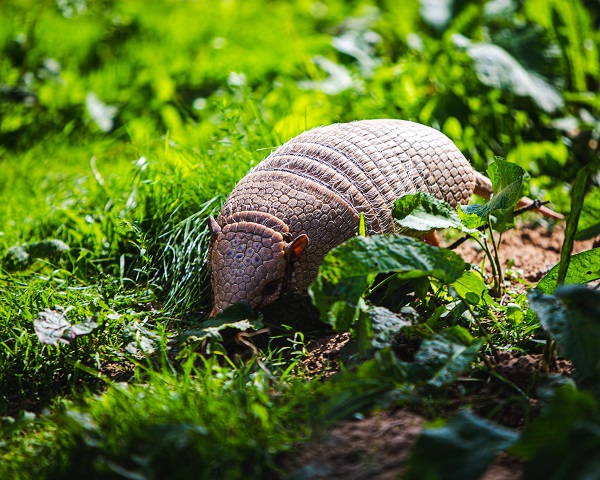Armadillos can be a problem for gardeners in Texas and other areas where these unusual, armored critters reside. Armadillos are mammals native to the warmer climates of North and South America, and early Spanish explorers gave them their current name, which means ‘little armored one’.

Since then, armadillos have earned other names, including possum-in-a-half-shell, dillos, walking road bumps, Texas turkeys or Hoover hogs, a nickname famously earned during the depression. For those who find an armadillo has burrowed in their garden or under the house foundation, armadillos are often referred to in terms that are not used in polite company.
The armadillo is the state mammal of Texas and that is where most are found in the United States. But they move farther north each year and now range in states north and east of Texas and have been spotted as far north as southern Indiana, Missouri, and Illinois. It is unlikely that armadillos will extend their range further into northern states because they cannot tolerate cold weather, and they are not found west of the Rocky Mountains.
The natural predators for armadillos include coyotes, dogs, bobcats, panthers, black bears, foxes and even raccoons. Man is another armadillo predator, and there are many armadillo recipes. Automobiles also pose a threat to armadillos, mainly because of the armadillos’ odd habit of jumping straight up when frightened. As a vehicle passes over an armadillo crossing the road, the armadillo’s instinct is to jump up, causing its early demise as it hits the undercarriage of the vehicle.
Armadillos are built for digging. With their powerful claws they can dig a burrow in no time, and they often dig several burrows in an area they prefer. Armadillos also dig for food. One armadillo can eat as many as 40,000 ants in a single meal and up to 200 pounds of insects over the course of a year.
Because armadillos consume so many insects, they are beneficial. But armadillos will occasionally nibble on some plants or eat berries, and if they happen across bird eggs on their daily travels, they’ll eat them too. Most often when they dig up a lawn they are searching for their favorite meal of earthworms and grubs. A weedy, overgrown lawn that is a haven for insects will also attract armadillos who want to feast on all those insects. A lawn that is well kept and free of brush, tall grass and rock piles will be less attractive to insects and the armadillos that feed on them.
If an armadillo is causing problems by digging under your house foundation or tearing up your plants as it digs, one course of action is to strongly encourage the critter to take its destructive habits elsewhere. Armadillos are not territorial animals, so they won’t mind too much if they must relocate.
Armadillos have sensitive noses, and they may leave an area if they think it stinks. Try dropping moth balls, chili powder or a rag soaked in vinegar down into the burrow or spray the area with a weak solution of ammonia mixed with water. Some folks cut up bars of strong-smelling soap and drop them into the burrows.
If none of these treatments succeed at discouraging the armadillo, you can try relocating the animal after capturing it in a live trap, using earthworms for bait. Contain the worms in a nylon stocking so the bait can’t crawl away. Be sure to check with local authorities first before relocating wayward armadillos, as it may not be legal to release trapped armadillos in all areas.
The best defense is to install a fence around the area, but the fence must extend at least a foot below ground to discourage armadillos from digging beneath it. Ideally the fence would be slanted outwards at a forty-degree angle.
If a fence is out of the question and armadillos are burrowing only in a small area, such as near a foundation, a section of wire mesh or fencing can be placed over the burrow while the armadillo is away from its home. When the armadillo returns and finds it can no longer enter its burrow, it may move on to friendlier territory. A section of chain-link fence can also be buried against the foundation to prevent further digging beneath the foundation.
Mike McGroarty is the owner of McGroarty Enterprises and the author of several books. You can visit his website at FreePlants.com and read his blog at MikeBackYardNursery.com.
Related Articles & Free Email Newsletter
How to Keep Cats Out of Your Garden
Protect Your Landscape from Winter Wildlife Damage




Comment here